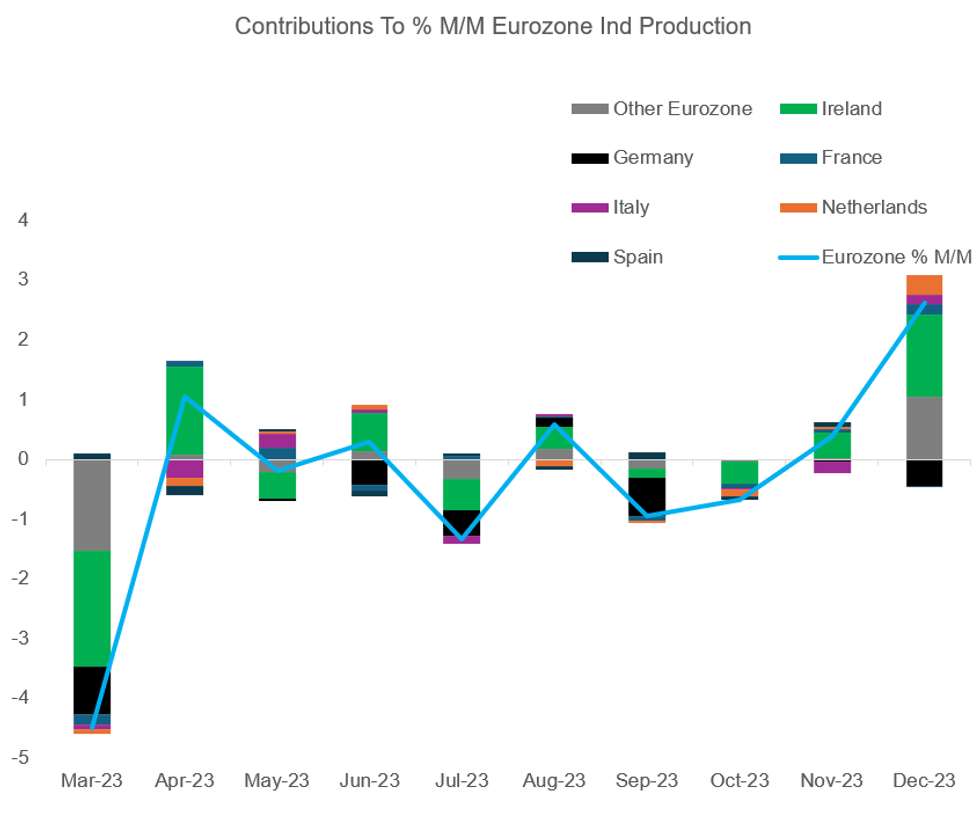-
Policy
Policy
Exclusive interviews with leading policymakers that convey the true policy message that impacts markets.
LATEST FROM POLICY: -
EM Policy
EM Policy
Exclusive interviews with leading policymakers that convey the true policy message that impacts markets.
LATEST FROM EM POLICY: -
G10 Markets
G10 Markets
Real-time insight on key fixed income and fx markets.
Launch MNI PodcastsFixed IncomeFI Markets AnalysisCentral Bank PreviewsFI PiFixed Income Technical AnalysisUS$ Credit Supply PipelineGilt Week AheadGlobal IssuanceEurozoneUKUSDeep DiveGlobal Issuance CalendarsEZ/UK Bond Auction CalendarEZ/UK T-bill Auction CalendarUS Treasury Auction CalendarPolitical RiskMNI Political Risk AnalysisMNI Political Risk - US Daily BriefMNI Political Risk - The week AheadElection Previews -
Emerging Markets
Emerging Markets
Real-time insight of emerging markets in CEMEA, Asia and LatAm region
-
Commodities
-
Credit
Credit
Real time insight of credit markets
-
Data
-
Global Macro
Global Macro
Actionable insight on monetary policy, balance sheet and inflation with focus on global issuance. Analysis on key political risk impacting the global markets.
Global MacroDM Central Bank PreviewsDM Central Bank ReviewsEM Central Bank PreviewsEM Central Bank ReviewsBalance Sheet AnalysisData AnalysisEurozone DataUK DataUS DataAPAC DataInflation InsightEmployment InsightGlobal IssuanceEurozoneUKUSDeep DiveGlobal Issuance Calendars EZ/UK Bond Auction Calendar EZ/UK T-bill Auction Calendar US Treasury Auction Calendar Global Macro Weekly -
About Us
To read the full story
Sign up now for free trial access to this content.
Please enter your details below.
Why MNI
MNI is the leading provider
of intelligence and analysis on the Global Fixed Income, Foreign Exchange and Energy markets. We use an innovative combination of real-time analysis, deep fundamental research and journalism to provide unique and actionable insights for traders and investors. Our "All signal, no noise" approach drives an intelligence service that is succinct and timely, which is highly regarded by our time constrained client base.Our Head Office is in London with offices in Chicago, Washington and Beijing, as well as an on the ground presence in other major financial centres across the world.
Real-time Actionable Insight
Get the latest on Central Bank Policy and FX & FI Markets to help inform both your strategic and tactical decision-making.
Free AccessMNI POLITICAL RISK - Trump's First Post Election Interview
MNI POLITICAL RISK ANALYSIS - Week Ahead 9-15 Dec
Industrial Production Ticked Up Even Excluding Questionable Ireland Data
Eurozone industrial production grew on a monthly basis in December in an upside surprise, at +2.6% M/M (vs -0.2% cons; +0.4% prior, revised from -0.3%), and +1.3% Y/Y (vs -4.0% cons; -6.8% prior). Total Eurozone figures were revised for 2023, with the index being corrected upwards by 0.1 points on average in each of the 12 months to December.
- The December increase was strongly driven by Ireland, which printed at +23.5% M/M, contributing +1.4pp to the total figure. Ireland is carrying out a review of the seasonal adjustment methodology currently, and figures have been notoriously highly volatile.
- Even excluding Ireland though the total increase amounted to +1.2% M/M, the highest outturn since August 2022. We knew Irish December IP growth prior to today's release so it should already have been accounted for in today's estimates.
- Looking at the other main countries in the Eurozone, Germany (-1.2% M/M vs -0.1% prior, contributing -0.4pp to the total figure) and Spain (-0.4% M/M vs +1.1% prior, no significant contribution) partially set off monthly gains from France (+1.1% M/M vs +0.4% prior, contributing +0.2pp), the Netherlands (+6.6% M/M vs +0.5% prior, contributing +0.3pp), and Italy (+1.1% M/M vs -1.3% prior, contributing +0.2pp). Other Eurozone countries contributed clearly positively to the release (1.0pp).
- From a sectoral perspective, the uptick was strongly driven by capital goods at +20.5% M/M (vs +0.8% prior), raising reliability concerns in this category.
- Other categories printed mixed results, with intermediate goods decreasing again, at -1.2% M/M (vs -0.7% prior), the fifth consecutive monthly decline; durable consumer goods and non-durable consumer goods came in at +0.5% M/M (-2.0% prior) and +0.2% M/M (+1.6% prior), respectively.
 MNI, Eurostat
MNI, Eurostat
To read the full story
Sign up now for free trial access to this content.
Please enter your details below.
Why MNI
MNI is the leading provider
of intelligence and analysis on the Global Fixed Income, Foreign Exchange and Energy markets. We use an innovative combination of real-time analysis, deep fundamental research and journalism to provide unique and actionable insights for traders and investors. Our "All signal, no noise" approach drives an intelligence service that is succinct and timely, which is highly regarded by our time constrained client base.Our Head Office is in London with offices in Chicago, Washington and Beijing, as well as an on the ground presence in other major financial centres across the world.
